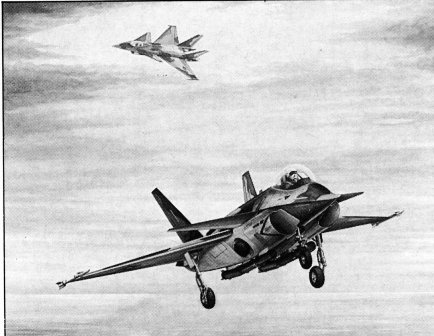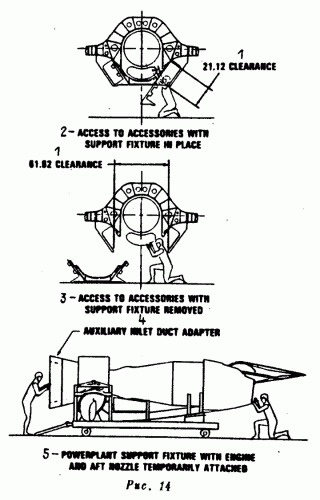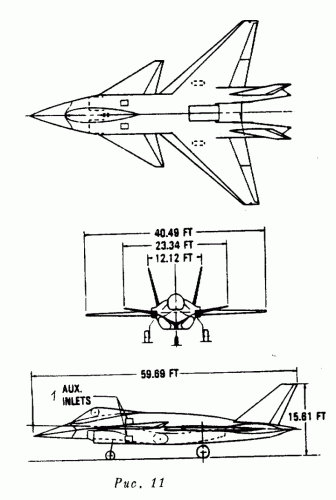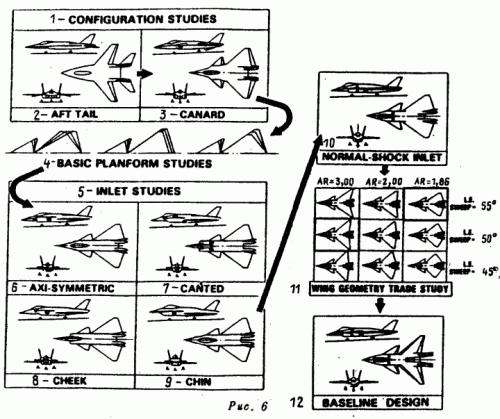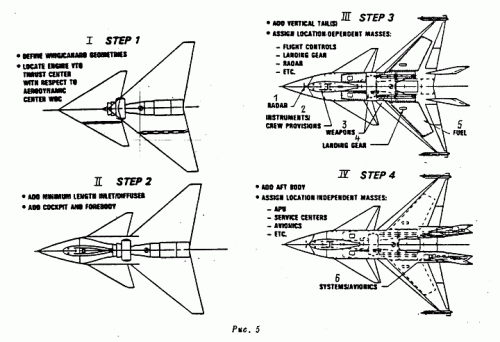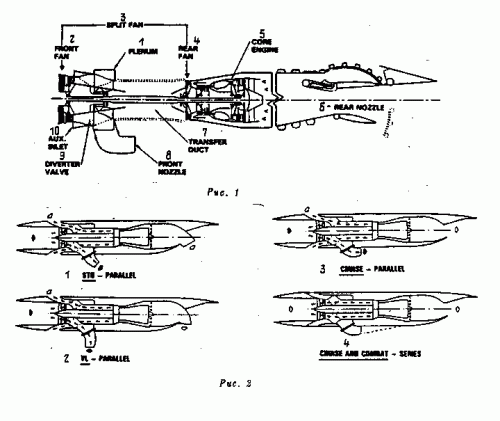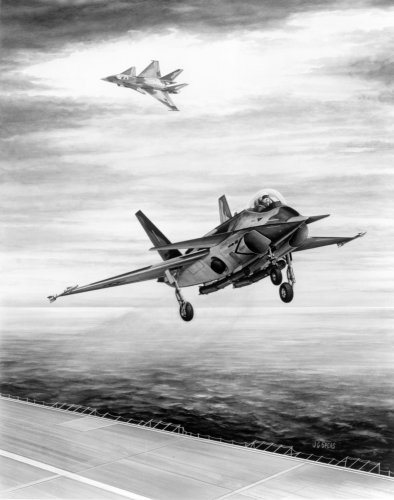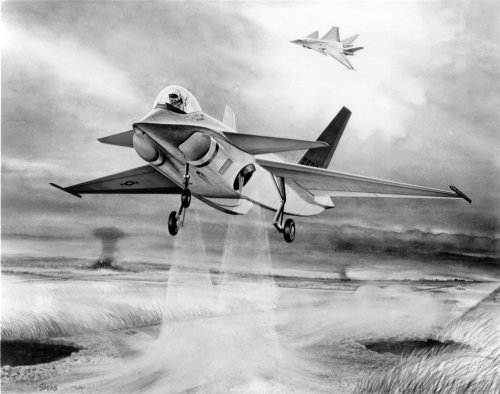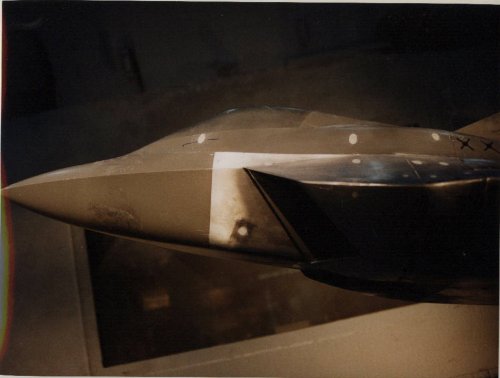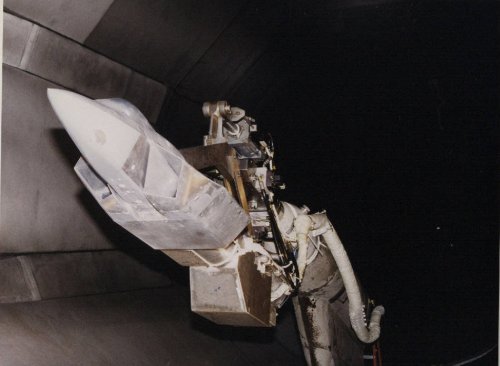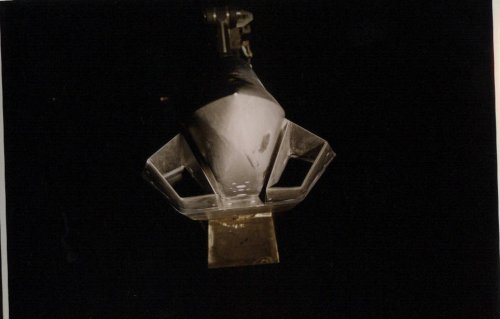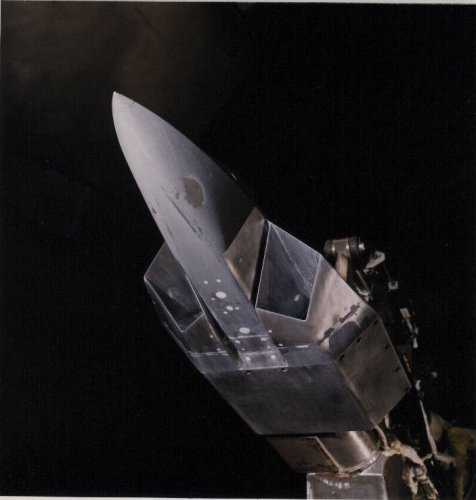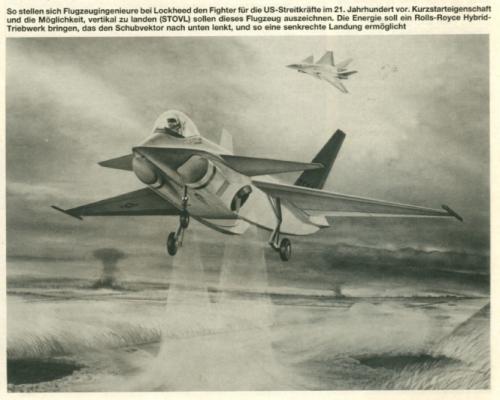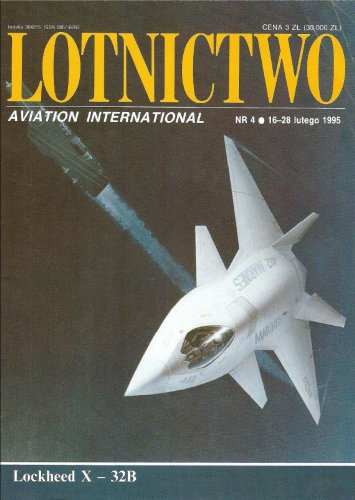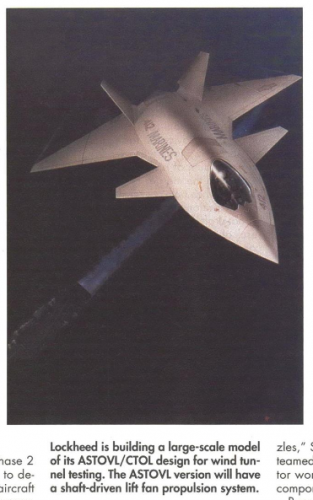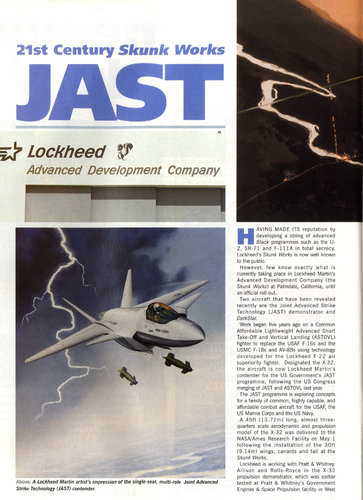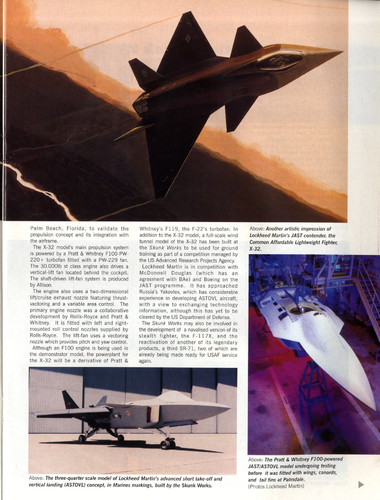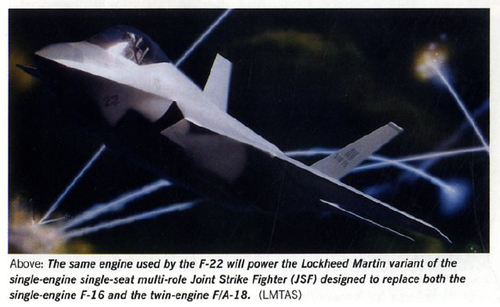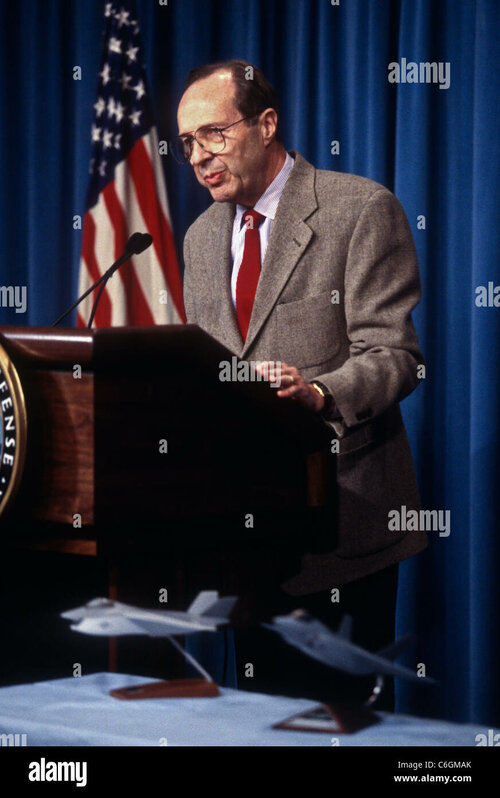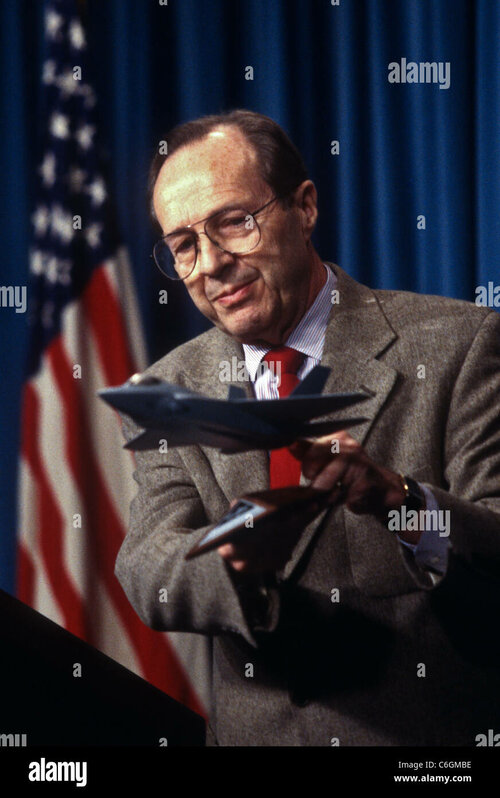You are using an out of date browser. It may not display this or other websites correctly.
You should upgrade or use an alternative browser.
You should upgrade or use an alternative browser.
Lockheed ASTOVL, JAST, JSF projects
- Thread starter Antonio
- Start date
- Joined
- 4 May 2008
- Messages
- 2,439
- Reaction score
- 762
LowObservable said:This is my understanding:
The LockMart design went from canard to quad-tail shortly before the CDA RFP deadline (which was in 1996). The main reason was that the carrier version was going to need a larger wing than the span-restricted (LH-class parking) CV/STOVL aircraft, and larger control surfaces. Scaling up a delta wing, while keeping its sweep angles constant (LO constraint) is difficult configuration-wise because the increase in root chord - in feet and inches - gets very large... so where do you put the (also larger) canard? A wing with less sweep and taper, and an aft tail likewise, made it easier to accommodate two wing designs on the same body shape.
The LSPM (large scale powered model) in the Google Earth photos was built as a canard, but I suspect that they modded it to get some idea of the difference in suck-down effects.
I attended a speech/dinner of the America Helicopter Society the other day. The keynote speaker was from ADP and participated in the early CALF/JAST/ASTOVL/JSF studies. He mentioned that besides carrier suitability, one driving consideration for switching to a conventional configuration from the original canard was a question of weapons bay placement. He mentioned that the bays ended up "too far aft" (i'm assuming because they have to straddle the cg; this could have all sorts of implications in aerodynamics and structures but he did not elaborate). The other reason, which i would have never anticipated, was that the canards could, under some conditions, mask the field of view of air launched weapons.
- Joined
- 1 April 2006
- Messages
- 11,394
- Reaction score
- 10,286
1988 Lockheed's Y.T.Chin team Hybrid Fan Vectored Thrust (HFVT) ASTOVL project that has started this thread. Translated SAE articlefrom Paralay's site.
[/font]
[/font]
Attachments
Last edited by a moderator:
- Joined
- 3 June 2006
- Messages
- 3,094
- Reaction score
- 3,963
Some Rafale influence there by the looks of it.
- Joined
- 1 April 2006
- Messages
- 11,394
- Reaction score
- 10,286
Bringing this thread back. M. Bevilaqua LinkedIn prfile says that he worked at Rockwell between 1975 and 1985
I have a suspicion he worked on the ill-fated XFV-12 thrust augmented fighter. Which was an utter failure. This probably helped when he "invented" the F-35 lift fan 15 years later.
I've found this paper on NTRS. https://ntrs.nasa.gov/search.jsp?R=19770052116
Ok, looks like Flateric ninja'd me long ago. This forum is so good.
he was Manager of Advanced Programs at Rockwell International’s Navy aircraft plant, where he led the design of VSTOL interceptor
I have a suspicion he worked on the ill-fated XFV-12 thrust augmented fighter. Which was an utter failure. This probably helped when he "invented" the F-35 lift fan 15 years later.
I've found this paper on NTRS. https://ntrs.nasa.gov/search.jsp?R=19770052116
Ok, looks like Flateric ninja'd me long ago. This forum is so good.
- Joined
- 3 June 2011
- Messages
- 18,335
- Reaction score
- 12,235
Archibald said:This probably helped when he "invented" the F-35 lift fan 15 years later.
Given that he got the patent for it, why would you imply he didn't?
https://www.google.com/patents/US5209428
- Joined
- 26 May 2006
- Messages
- 34,897
- Reaction score
- 15,760
- Joined
- 9 October 2009
- Messages
- 21,973
- Reaction score
- 13,623
Ghostrider. Unfortunately, in what can only be called an act of pure stupidity, practically all of the technical data from this design is reported to have been later deliberately destroyed.
Colonial-Marine
UAVs are now friend, drones are the real enemy.
- Joined
- 5 October 2009
- Messages
- 1,470
- Reaction score
- 1,323
Since the fighter was limited in overall length due to the requirement to fit in LHAs and LHDs would the canard-delta layout have provided superior performance compared to the "conventional" layout eventually adopted?
Colonial-Marine
UAVs are now friend, drones are the real enemy.
- Joined
- 5 October 2009
- Messages
- 1,470
- Reaction score
- 1,323
Is there any more detailed information on the development of the design between Configuration 141B (which included the three-bearing swivel nozzle) and the final configuration selected for the X-35 prototypes?
I'm uncertain of the source of this image but it's all I seem to be able to find on the matter.

What I find interesting is the single vertical tail utilized for a period of time which to the best of my knowledge is a cardinal sin if you are hoping to achieve a VLO radar signature.
I'm uncertain of the source of this image but it's all I seem to be able to find on the matter.

What I find interesting is the single vertical tail utilized for a period of time which to the best of my knowledge is a cardinal sin if you are hoping to achieve a VLO radar signature.
- Joined
- 9 October 2009
- Messages
- 21,973
- Reaction score
- 13,623
What I find interesting is the single vertical tail utilized for a period of time which to the best of my knowledge is a cardinal sin if you are hoping to achieve a VLO radar signature.
It primarily was supposed to be a cost reduction measure if I'm not mistaken, with a bit of engineering simplification as a secondary objective I think. The old 'pennywise, pound foolish approach' in other words.
- Joined
- 1 April 2006
- Messages
- 11,394
- Reaction score
- 10,286
Is there any more detailed information on the development of the design between Configuration 141B (which included the three-bearing swivel nozzle) and the final configuration selected for the X-35 prototypes?
- Joined
- 3 June 2006
- Messages
- 3,094
- Reaction score
- 3,963
Video:Lockheed Martin - The Hat Trick History: Mission X
On July 20, 2001, Lockheed Martin, U.S. military officials and the aerospace community focused their attention on a single X-35, the concept demonstrator aircraft that would later be known as the F-35, stationed in Edwards Air Force Base, California, as it embarked on a journey to pass one of the most significant flight tests in aviation history – Mission X.
Code:
https://youtu.be/JlyUUIQxtyA- Joined
- 4 May 2008
- Messages
- 2,439
- Reaction score
- 762
I saw Paul Bevilaqua's webinar the other day. On the canard vs. tailed configuration, he says he thought the canard was going to get selected. He said management perceived the canard as a risk, and did not want to add a second one to the novel propulsion system.
He also told of the bias against canards, and how Harry Hillaker was once asked what the best position for a canard surface was, and he said "the best place for a canard is in somebody else’s airplane".
I'm sure there were other, better reasons, for adopting the tailed configuration - like the ones mentioned in the posts above - but i thought his recollection was interesting.
He also mentioned that for the -C variant, he thought it would have been straightforward to use the existing roll posts to duct air to blow the flaps, but the Navy was adamant about not wanting boundary layer control, and directed Lockheed to build the bigger wing.
Finally, on the topic of shaft-driven lift fan versus gas-driven, he said the latter did not have adequate response time to be useful for pitch control, so MDD had to add a bleed air pitch nozzle on theirs.
He also told of the bias against canards, and how Harry Hillaker was once asked what the best position for a canard surface was, and he said "the best place for a canard is in somebody else’s airplane".
I'm sure there were other, better reasons, for adopting the tailed configuration - like the ones mentioned in the posts above - but i thought his recollection was interesting.
He also mentioned that for the -C variant, he thought it would have been straightforward to use the existing roll posts to duct air to blow the flaps, but the Navy was adamant about not wanting boundary layer control, and directed Lockheed to build the bigger wing.
Finally, on the topic of shaft-driven lift fan versus gas-driven, he said the latter did not have adequate response time to be useful for pitch control, so MDD had to add a bleed air pitch nozzle on theirs.
From perusing this thread, the configuration here is quite reminiscent of Lockheed’s original submission for the ATF with trapezoidal wings and LEX hood for the ATF RFP prior to the summer 1987 redesign after the down select.two more Raymer designs for ASTOVL fighters while he was at Lockheed at early 90s plus schematics for SDLF, SFIH and RIVET
I’m sure some others have also noticed, but it looks like Lockheed’s ASTOVL/CALF LSPM had interfaces for both canard and stabilitor empennage configurations.
Last edited:
- Joined
- 1 April 2006
- Messages
- 11,394
- Reaction score
- 10,286
Colonial-Marine
UAVs are now friend, drones are the real enemy.
- Joined
- 5 October 2009
- Messages
- 1,470
- Reaction score
- 1,323
Main flaw or default? I'm not sure I follow what you're asking.Who can tell me the main flaw or default in the JAST designations generally ?.
Kat Tsun
eeeeeeeeeeeeeee
- Joined
- 16 June 2013
- Messages
- 1,371
- Reaction score
- 1,778
I think he's asking for a timeline of designations from SSF to JAST? There's one on John Pike's website.
 www.globalsecurity.org
www.globalsecurity.org
DARPA / Navy Common Affordable Lightweight Fighter (CALF) 1993-1994
- Joined
- 26 May 2006
- Messages
- 34,897
- Reaction score
- 15,760
Who can tell me the main flaw or default in the JAST designations generally ?.
To be not enter in debate,the main default is the lift engine was not useful except in vertical
flight only,and not in horizontal cruise.
- Joined
- 26 May 2006
- Messages
- 34,897
- Reaction score
- 15,760
Who can tell me the main flaw or default in the JAST designations generally ?.
To be not enter in debate,the main default is the lift engine was not useful except in vertical
flight only,and not in horizontal cruise.
By the way,it was not my opinion only,I am just amateur,but group of scientists mentioned that,beside
the dust from lift engine turn down and entered the intake of the main engine,costed a little bit of decreasing
the propulsion.
I worked on the McDonnell Douglas side of ASTOVL and JAST, then Boeing's JSF. The real backstory of how these are all connected (along with SSF) has somehow never been told, even though for years it was right out in the open on the jast.mil website. As the history faded into the background with the passing years, the relevant pages were cleaned out, and as far as I know I may have the only surviving record. I had made screencaps of the more interesting parts which I'll attach here. SNIP
I think it's important for people to understand the whole story behind this weird JSF history story, because in my experience very few of us who actually worked on these programs ever knew the truth, even though it was posted by the Government for years and years.
That's a fascinating account. "The ends justify the means" - to Lockheed and DARPA the prospect of a stealth VSTOL fighter were so exciting they bended the rules ?
Put otherwise: SDLF ( = Bevilaqua breakthrough) made stealth-VSTOL a reality ; so SDLF design HAD to win - at any cost ?
red admiral
ACCESS: Top Secret
- Joined
- 16 September 2006
- Messages
- 1,805
- Reaction score
- 2,377
SDLF is the best fit for the JSF requirements set rather than a key enabler for stealth VSTOL in general. Or maybe the JSF requirements set was written around SDLF...
From how things turned out, Lift + Lift/cruise seems the best solution; higher performance from the lower size/mass lift engine, and lower cost from re-use of F119. But was ruled out in the requirements for reasons... like predicting much lower costs for engine development than reality
Whereas if the JSF requirements had called for higher kinematic performance then the likes of lift/cruise become better choices as the thrust/weight required in Hover and Up and Away is much closer, removing the primary advantage of SDLF whilst keeping the risk and complexity
From how things turned out, Lift + Lift/cruise seems the best solution; higher performance from the lower size/mass lift engine, and lower cost from re-use of F119. But was ruled out in the requirements for reasons... like predicting much lower costs for engine development than reality
Whereas if the JSF requirements had called for higher kinematic performance then the likes of lift/cruise become better choices as the thrust/weight required in Hover and Up and Away is much closer, removing the primary advantage of SDLF whilst keeping the risk and complexity
stever_sl
ACCESS: Confidential
- Joined
- 31 August 2010
- Messages
- 94
- Reaction score
- 535
The MDC/Northrop/BAe competitor was lift plust lift cruise, and the Marines told us over and over that they weren't going to buy any STOVL airplane that had more than one engine. Displaying the usual monumental arrogance that MDC was famous for, our management refused to accept that, and insisted on explaining over and over why our design was more efficient and therefore should be bought. In the end, the Marines proved that they weren't kidding and gave a big thumbs-down to our STOVL variant. Lockheed won, and soon afterward we found ourselves merged with Boeing.SDLF is the best fit for the JSF requirements set rather than a key enabler for stealth VSTOL in general. Or maybe the JSF requirements set was written around SDLF...
From how things turned out, Lift + Lift/cruise seems the best solution; higher performance from the lower size/mass lift engine, and lower cost from re-use of F119. But was ruled out in the requirements for reasons... like predicting much lower costs for engine development than reality
Whereas if the JSF requirements had called for higher kinematic performance then the likes of lift/cruise become better choices as the thrust/weight required in Hover and Up and Away is much closer, removing the primary advantage of SDLF whilst keeping the risk and complexity
- Joined
- 3 June 2011
- Messages
- 18,335
- Reaction score
- 12,235
A shame too. The MDC variant was my favorite of the three.The MDC/Northrop/BAe competitor was lift plust lift cruise, and the Marines told us over and over that they weren't going to buy any STOVL airplane that had more than one engine. Displaying the usual monumental arrogance that MDC was famous for, our management refused to accept that, and insisted on explaining over and over why our design was more efficient and therefore should be bought. In the end, the Marines proved that they weren't kidding and gave a big thumbs-down to our STOVL variant. Lockheed won, and soon afterward we found ourselves merged with Boeing.SDLF is the best fit for the JSF requirements set rather than a key enabler for stealth VSTOL in general. Or maybe the JSF requirements set was written around SDLF...
From how things turned out, Lift + Lift/cruise seems the best solution; higher performance from the lower size/mass lift engine, and lower cost from re-use of F119. But was ruled out in the requirements for reasons... like predicting much lower costs for engine development than reality
Whereas if the JSF requirements had called for higher kinematic performance then the likes of lift/cruise become better choices as the thrust/weight required in Hover and Up and Away is much closer, removing the primary advantage of SDLF whilst keeping the risk and complexity
pedrospe
ACCESS: Secret
- Joined
- 9 February 2010
- Messages
- 395
- Reaction score
- 215
I absolutely agree with you, the MDC/Northrop was also my favorite, and i still think it was the better aircraft for the Air force an Navy, and probably the most superior in air to air combat, and probably stealthier than the F-35, they choose the Lockheed Martin aircraft, only because of it's STOVL variant, it is real a shame, that the U.S Government, imposed the Air force and Navy, the Lockheed aircraft, just because they wanted a stealth STOVL fighter, that only the Marines and the UK use in it's STOVL variant and in very limited numbers.A shame too. The MDC variant was my favorite of the three.The MDC/Northrop/BAe competitor was lift plust lift cruise, and the Marines told us over and over that they weren't going to buy any STOVL airplane that had more than one engine. Displaying the usual monumental arrogance that MDC was famous for, our management refused to accept that, and insisted on explaining over and over why our design was more efficient and therefore should be bought. In the end, the Marines proved that they weren't kidding and gave a big thumbs-down to our STOVL variant. Lockheed won, and soon afterward we found ourselves merged with Boeing.SDLF is the best fit for the JSF requirements set rather than a key enabler for stealth VSTOL in general. Or maybe the JSF requirements set was written around SDLF...
From how things turned out, Lift + Lift/cruise seems the best solution; higher performance from the lower size/mass lift engine, and lower cost from re-use of F119. But was ruled out in the requirements for reasons... like predicting much lower costs for engine development than reality
Whereas if the JSF requirements had called for higher kinematic performance then the likes of lift/cruise become better choices as the thrust/weight required in Hover and Up and Away is much closer, removing the primary advantage of SDLF whilst keeping the risk and complexity
- Joined
- 3 June 2011
- Messages
- 18,335
- Reaction score
- 12,235
The upside of demanding the STOVL variant is it lowered the bar to entry for carriers. Now Japan, SK, the UK, and others will be able to field F-35s without the need for catapults and arresting gear.I absolutely agree with you, the MDC/Northrop was also my favorite, and i still think it was the better aircraft for the Air force an Navy, and probably the most superior in air to air combat, and probably stealthier than the F-35, they choose the Lockheed Martin aircraft, only because of it's STOVL variant, it is real a shame, that the U.S Government, imposed the Air force and Navy, the Lockheed aircraft, just because they wanted a stealth STOVL fighter, that only the Marines and the UK use in it's STOVL variant and in very limited numbers.A shame too. The MDC variant was my favorite of the three.The MDC/Northrop/BAe competitor was lift plust lift cruise, and the Marines told us over and over that they weren't going to buy any STOVL airplane that had more than one engine. Displaying the usual monumental arrogance that MDC was famous for, our management refused to accept that, and insisted on explaining over and over why our design was more efficient and therefore should be bought. In the end, the Marines proved that they weren't kidding and gave a big thumbs-down to our STOVL variant. Lockheed won, and soon afterward we found ourselves merged with Boeing.SDLF is the best fit for the JSF requirements set rather than a key enabler for stealth VSTOL in general. Or maybe the JSF requirements set was written around SDLF...
From how things turned out, Lift + Lift/cruise seems the best solution; higher performance from the lower size/mass lift engine, and lower cost from re-use of F119. But was ruled out in the requirements for reasons... like predicting much lower costs for engine development than reality
Whereas if the JSF requirements had called for higher kinematic performance then the likes of lift/cruise become better choices as the thrust/weight required in Hover and Up and Away is much closer, removing the primary advantage of SDLF whilst keeping the risk and complexity
- Joined
- 5 May 2007
- Messages
- 1,483
- Reaction score
- 2,859
Possibly also the better STOVL aircraft too, notwithstanding the US Marines' insistence on only having one engine.I absolutely agree with you, the MDC/Northrop was also my favorite, and i still think it was the better aircraft for the Air force an Navy, and probably the most superior in air to air combat, and probably stealthier than the F-35, they choose the Lockheed Martin aircraft, only because of it's STOVL variant, it is real a shame, that the U.S Government, imposed the Air force and Navy, the Lockheed aircraft, just because they wanted a stealth STOVL fighter, that only the Marines and the UK use in it's STOVL variant and in very limited numbers.
Meanwhile, AIUI the Boeing entry was basically a low-cost carrierborne strike aircraft that had air-to-air and STOVL imposed on it. Surprising it lasted as long as it did, given that history.
pedrospe
ACCESS: Secret
- Joined
- 9 February 2010
- Messages
- 395
- Reaction score
- 215
i agree with you, i think Boeing didn't do enough for is't entry on the JSF program, as Lockheed or MDC/Northrop did on their designs, nevertheless, i think it was a mistake, imposing the F-35 to the Air force and Navy, just because they wanted a STOVL advanced jet for the Marines, i'm not saying that the F-35 is a bad aircraft, but if it didn't have the limitations of the STOVL variant on it's design, we could have had, a very superior interceptor and dual role mission aircraft, like the F-16, with of course stealth on it's design, and with a bigger internal weapons bay, than the one of the F-35, which limits a lot, the weapons carried inside, the MDC/Northrop, looked to me like the better design for the missions the Air force and Navy would use it on and for any future upgrade.Possibly also the better STOVL aircraft too, notwithstanding the US Marines' insistence on only having one engine.I absolutely agree with you, the MDC/Northrop was also my favorite, and i still think it was the better aircraft for the Air force an Navy, and probably the most superior in air to air combat, and probably stealthier than the F-35, they choose the Lockheed Martin aircraft, only because of it's STOVL variant, it is real a shame, that the U.S Government, imposed the Air force and Navy, the Lockheed aircraft, just because they wanted a stealth STOVL fighter, that only the Marines and the UK use in it's STOVL variant and in very limited numbers.
Meanwhile, AIUI the Boeing entry was basically a low-cost carrierborne strike aircraft that had air-to-air and STOVL imposed on it. Surprising it lasted as long as it did, given that history.
- Joined
- 3 June 2011
- Messages
- 18,335
- Reaction score
- 12,235
And no F-35s on 11 LHA/Ds (eventually). None on Japanese, South Korean, and others' carriers. IMO the trade was worth it.i agree with you, i think Boeing didn't do enough for is't entry on the JSF program, as Lockheed or MDC/Northrop did on their designs, nevertheless, i think it was a mistake, imposing the F-35 to the Air force and Navy, just because they wanted a STOVL advanced jet for the Marines, i'm not saying that the F-35 is a bad aircraft, but if it didn't have the limitations of the STOVL variant on it's design, we could have had, a very superior interceptor and dual role mission aircraft, like the F-16, with of course stealth on it's design, and with a bigger internal weapons bay, than the one of the F-35, which limits a lot, the weapons carried inside, the MDC/Northrop, looked to me like the better design for the missions the Air force and Navy would use it on and for any future upgrade.Possibly also the better STOVL aircraft too, notwithstanding the US Marines' insistence on only having one engine.I absolutely agree with you, the MDC/Northrop was also my favorite, and i still think it was the better aircraft for the Air force an Navy, and probably the most superior in air to air combat, and probably stealthier than the F-35, they choose the Lockheed Martin aircraft, only because of it's STOVL variant, it is real a shame, that the U.S Government, imposed the Air force and Navy, the Lockheed aircraft, just because they wanted a stealth STOVL fighter, that only the Marines and the UK use in it's STOVL variant and in very limited numbers.
Meanwhile, AIUI the Boeing entry was basically a low-cost carrierborne strike aircraft that had air-to-air and STOVL imposed on it. Surprising it lasted as long as it did, given that history.
Similar threads
-
-
McDD/Northrop/BAe ASTOVL/MRF/JAST/JSF studies
- Started by Antonio
- Replies: 255
-
HELP! Lockheed A-X, A/F-X, ASTOVL, ATA, SSF, MRF, CALF and JAST
- Started by Steve Pace
- Replies: 4
-
ASTOVL without the JSF program - What would it have meant?
- Started by SteveO
- Replies: 16
-
McDonnell Douglas Concept 2403 in 1/72 ( in progress )
- Started by piko1
- Replies: 1

